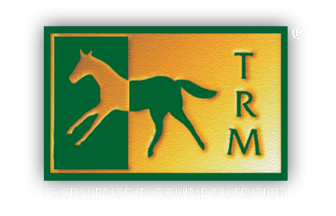Vitamin E – Why it is needed by the performance horse
Vitamin E – Why it is needed by the performance horse
What is Vitamin E?
Vitamin E is a fat soluble vitamin. It was first discovered in 1922 by Evans and Bishop who found that feeding rancid lard to pregnant rats resulted in foetal reabsorption. A “factor” within wheat germ oil was found to prevent this occurring and was named vitamin E. It was identified chemically as a-tocopherol and, following the determination of its chemical structure, it was synthesised in 1938.
Vitamin E research continued and a group of 8 compounds, 4 tocopherols and 4 tocotrienols, were shown to possess vitamin E activity. These compounds have a 6- chromanol ring structure and an isoprenoid side chain; the extent of “vitamin E” activity depending on the placement of the methyl groups on the ring. The terms a, ß‚ y and X are used to describe this methyl group placement and the a-tocopherol form has the greatest biological activity.
Sources of Vitamin E
Vitamin E is produced naturally within plants as RRR-a-tocopherol or, d-a-tocopherol. The amount of d-a-tocopherol in feeds varies greatly and, the content can decline rapidly due to processing or prolonged storage. This is because it is naturally present in the alcohol form which is highly susceptible to oxidative destruction and is thus unstable.
Functions of Vitamin E
The most important function of vitamin E is its action as a cellular antioxidant, preventing the oxidation of unsaturated lipids to peroxides within cell membranes by free radicals. The latter are the normal by-products of metabolic processes occurring within the body whose production increases during exercise and may disturb redox reactions in muscle cells, leading to muscle fatigue. Vitamin E deficiency has been shown to reduce endurance in the rat. Exercise has been shown to increase lipid hydroperoxide levels in showjumpers and to a lesser extent in dressage horses. Oxidative stress in exercising horses is represented by an association between increased lipid per oxidation and increased leakage of the lipoprotein membranes of the muscle cells. Interest in the role of vitamin E for human athletes is also increasing as it has been shown to have a protective effect against free-radical–induced muscle damage. Vitamin E molecules act as scavengers of free radicals through the action of single, highly reactive electrons in their outer shells; once the electron is donated, an a-tocopherol radical is produced that requires another antioxidant to reactivate the a-tocopherol.
Good heart and lung function is essential for the performance horse and vitamin E removes free radicals formed in respiratory and cardiac muscles as well as maintaining red blood cell stability. It is essential for maintenance of the nervous system, preventing oxidation of the lipid of nerve membranes and it promotes immune system function. Frequent disease outbreaks or poor disease resistance may be related to inadequate vitamin E status. Vitamin E supplementation has been shown to improve immune response to novel antigens, such as tetanus toxoid and equine influenza virus.
Interactions with other nutrients
There is a close relationship between vitamin E, selenium and vitamin C (ascorbic acid). Vitamin C, an important antioxidant in its own right, recycles the a-tocopherol radical back to the active form of a-tocopherol. Selenium forms part of the cellular enzyme glutathione peroxidase and is located inside the aqueous cell cytosol and mitochondrial matrix. It destroys any peroxides formed before they can cause damage to cell membranes. To some extent selenium and vitamin E are interchangeable but they each have unique functions and, below a critical point no amount of one can prevent deficiency symptoms of the other appearing. It has been reported that vitamin E and selenium supplementation
Deficiency
Vitamin E deficiency has been identified as a factor involved with two neurological disorders of horses, equine motor neurone disease (EMND) and equine degenerative myeloencephalopathy (EDM). EMND has been reported with the highest frequency in 4-9 year old horses but in a group of horses fed similar diets, not all horses will go on to develop the condition. It seems that an individual’s susceptibility to a disturbed antioxidant/pro-oxidant balance can lead to progression of the disease; EMND tends to develop after a prolonged vitamin E deficiency. Vitamin E appears to have a protective effect against oxidative damage within the spinal cord of horses, the actual neuro-anatomical site depending on the age of the horse. EDM usually develops in younger, growing animals, with some genotypes having a greater tendency to develop the disease than others; the spinal cord and caudal medulla oblongata degenerate. Horses suffering from EDM require between 2000-6000mg vitamin E per day.
Summary
A performance horse must consume enough vitamin E to support optimal muscular and neurological activity. Vitamin E is an essential antioxidant and, together with selenium and vitamin C, it helps to maintain good health and performance. Variable feed levels of vitamin E necessitate supplementation, the precise amount depending on the level of activity but, can be as high as 8 to 9mg/kg BW for the horse in hard work.
